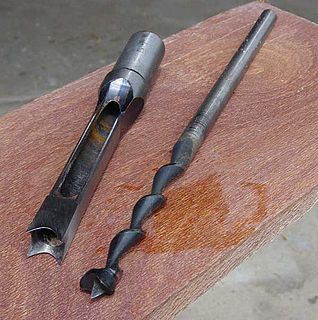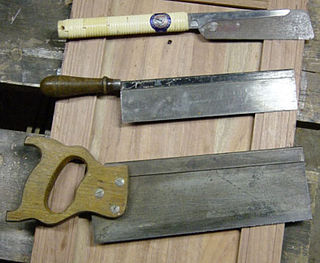
A chisel is a tool with a characteristically shaped cutting edge of blade on its end, for carving or cutting a hard material such as wood, stone, or metal by hand, struck with a mallet, or mechanical power. The handle and blade of some types of chisel are made of metal or of wood with a sharp edge in it.

A mortiseand tenon joint connects two pieces of wood or other material. Woodworkers around the world have used it for thousands of years to join pieces of wood, mainly when the adjoining pieces connect at right angles.

A hand plane is a tool for shaping wood using muscle power to force the cutting blade over the wood surface. Some rotary power planers are motorized power tools used for the same types of larger tasks, but are unsuitable for fine-scale planing, where a miniature hand plane is used.

A lap joint or overlap joint is a joint in which the members overlap. Lap joints can be used to join wood, plastic, or metal. A lap joint can be used in woodworking for joining wood together.

A dovetail joint or simply dovetail is a joinery technique most commonly used in woodworking joinery (carpentry), including furniture, cabinets, log buildings, and traditional timber framing. Noted for its resistance to being pulled apart, the dovetail joint is commonly used to join the sides of a drawer to the front. A series of 'pins' cut to extend from the end of one board interlock with a series of 'tails' cut into the end of another board. The pins and tails have a trapezoidal shape. Once glued, a wooden dovetail joint requires no mechanical fasteners.

The Japanese saw or nokogiri (鋸) is a type of saw used in woodworking and Japanese carpentry that cuts on the pull stroke, unlike most European saws that cut on the push stroke. Japanese saws are the best known pull saws, but they are also used in China, Iran, Iraq, Korea, Nepal and Turkey. Among European saws, both coping saws for woodworking and jeweler's saws for metal working also cut on the pull stroke like Japanese saws. Cutting on the pull stroke is claimed to cut more efficiently and leave a narrower cut width. On the other hand, a pull stroke does not easily permit putting one's body weight behind a stroke. This can be readily solved by using a vice or clamping. Another disadvantage, due to the arrangement and form of the teeth, is that Japanese saws do not work as well on hardwoods as European saws do. Japanese saws were originally intended for comparatively soft woods like cypress and pine whereas European saws were intended for hard woods like oak and maple.

The steel square is a tool used in carpentry. Carpenters use various tools to lay out structures that are square, many of which are made of steel, but the name steel square refers to a specific long-armed square that has additional uses for measurement, especially of various angles. It consists of a long, wider arm and a shorter, narrower arm, which meet at an angle of 90 degrees. Today the steel square is more commonly referred to as the framing square or carpenter's square, and such squares are no longer invariably made of steel ; they can also be made of aluminum or polymers, which are light and resistant to rust.

A mortiser or morticer is a specialized woodworking machine used to cut square or rectangular holes in a piece of lumber (timber), such as a mortise in a mortise and tenon joint.

A backsaw is any hand saw which has a stiffening rib on the edge opposite the cutting edge, enabling better control and more precise cutting than with other types of saws. Backsaws are normally used in woodworking for precise work, such as cutting dovetails, mitres, or tenons in cabinetry and joinery. Because of the stiffening rib, backsaws are limited in the depth to which they can cut. Backsaws usually have relatively closely spaced teeth, often with little or no set.

Frame and panel construction, also called rail and stile, is a woodworking technique often used in the making of doors, wainscoting, and other decorative features for cabinets, furniture, and homes. The basic idea is to capture a 'floating' panel within a sturdy frame, as opposed to techniques used in making a slab solid wood cabinet door or drawer front, the door is constructed of several solid wood pieces running in a vertical or horizontal direction with exposed endgrains. Usually, the panel is not glued to the frame but is left to 'float' within it so that seasonal movement of the wood comprising the panel does not distort the frame.

A box joint is a woodworking joint made by cutting a set of complementary, interlocking profiles in two pieces of wood, which are then joined (usually) at right angles, usually glued. The glued box joint has a high glued surface area resulting in a strong bond, on a similar principle to a finger joint. Box joints are used for corners of boxes or box-like constructions, hence the name. The joint does not have the same interlocking properties as a dovetail joint, but is much simpler to make, and can be mass-produced fairly easily.

A butt joint is a technique in which two pieces of material are joined by simply placing their ends together without any special shaping. The name "butt joint" comes from the way the material is joined together. The butt joint is the simplest joint to make since it merely involves cutting the material to the appropriate length and butting them together. It is also the weakest because unless some form of reinforcement is used, it relies upon glue or welding alone to hold it together. Because the orientation of the material usually presents only one end to a long gluing or welding surface, the resulting joint is inherently weak.

A face frame in cabinet making is the frame fixed to the front of a cabinet carcass which obscures the edges of the carcass and provides the fixing point for doors and other external hardware. A face frame provides strength to the front of a cabinet and is also considered a visual feature of particular styles of furniture.

A halved joint is a woodworking joint in which the two members are joined by removing material from each at the point of intersection so that they overlap. The halved joint is differentiated from the lap joint in that the members are joined on edge, rather than on flat.
This glossary of woodworking lists a number of specialized terms and concepts used in woodworking, carpentry, and related disciplines.

The forms of Chinese furniture evolved along three distinct lineages which dates back to 1000 BC, based on frame and panel, yoke and rack and bamboo construction techniques. Chinese home furniture evolved independently of Western furniture into many similar forms including chairs, tables, stools, cupboards, cabinets, beds and sofas. Until about the 10th century CE the Chinese sat on mats or low platforms using low tables, in typical Asian style, but then gradually moved to using high tables with chairs.

Hammer-headed tenon joints are one method that can be used to join curved members of joinery components.

A twybil is a hand tool used for green woodworking. It is used for chopping out mortises when timber framing, or making smaller pieces such as gates. It combines chopping and levering functions in a single tool.

A mortise gauge or mortice gauge is a woodworking tool used by a carpenter or joiner to scribe mortise and tenon joints on wood prior to cutting. Mortise gauges are commonly made of hardwood with brass fittings.



















